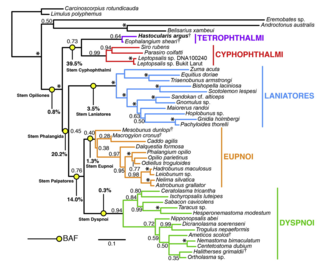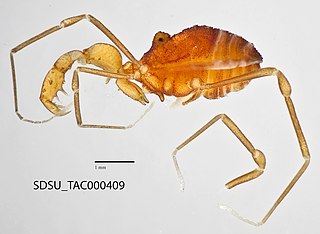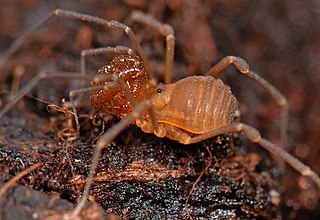
The Opiliones are an order of arachnids, colloquially known as harvestmen, harvesters, harvest spiders, or daddy longlegs. As of July 2024, over 6,650 species of harvestmen have been discovered worldwide, although the total number of extant species may exceed 10,000. The order Opiliones includes five suborders: Cyphophthalmi, Eupnoi, Dyspnoi, Laniatores, and Tetrophthalmi, which were named in 2014.

Laniatores is the largest suborder of the arachnid order Opiliones with over 4,200 described species worldwide. The majority of the species are highly dependent on humid environments and usually correlated with tropical and temperate forest habitats.

Samooidea is a large superfamily in the Grassatores group of harvestmen. It includes around 380 species distributed throughout the tropics. They are characterized by the complex male genitalia, with eversible complementary sclerites.

Cosmetidae is a family of harvestmen in the suborder Laniatores. With over 700 species, it is one of the largest families in Opiliones. They are endemic of the New World with a Nearctic-Neotropical distribution where a large fraction of the diversity of Opiliones are represented by this single family. Cosmetidae have the northern extent of their range into the USA, where a small number species occur in the southern states. However, the family is especially diverse in Mexico, Central America and northern South America; especially the Andean realms. Their range also extends further south into Argentina and southern Brazil, but they are absent in Chile. Cosmetidae are prevalent in Amazonian region, but only relatively few also occur in Brazilian Atlantic Forest. Several species are also found in the Caribbean.

Epedanidae is a family of the harvestman infraorder Grassatores with about 200 described species. They are the sister group of the Gonyleptoidea.

The Cranaidae are a family of neotropical harvestmen within the suborder Laniatores.
The Zalmoxidae are a family of harvestmen within the suborder Laniatores.
Escadabiidae is a small neotropical family of the harvestman infraorder Grassatores with six described species.
Kimulidae is a small neotropical family of the harvestman infraorder Grassatores with about thirty described species.

Samoidae is a family of the harvestman infraorder Grassatores with about fifty described species.

Harvestmen (Opiliones) are an order of arachnids often confused with spiders, though the two orders are not closely related. Research on harvestman phylogeny is in a state of flux. While some families are clearly monophyletic, that is share a common ancestor, others are not, and the relationships between families are often not well understood.

Theromaster brunneus is a species of armoured harvestman in the family Travuniidae. It is found in North America.

Travunioidea is a superfamily of armoured harvestmen in the order Opiliones. There are 4 families and around 75 described species in Travunioidea.

Neosiro exilis is a species of mite harvestman in the family Sironidae. It is found in North America.

Undulus is a genus of armoured harvestmen in the family Phalangodidae. There is at least one described species in Undulus, U. formosus.
Calicina mariposa is a species of armoured harvestman in the family Phalangodidae. It is found in North America.

Cryptomastridae is a family of armoured harvestmen in the order Opiliones. There are two genera and four described species in Cryptomastridae, found in Oregon and Idaho.
Nippononychus is a genus of harvestman in the family Paranonychidae. There is one described species in Nippononychus, N. japonicus, endemic to Japan.
Triaenonychoidea is a superfamily of armoured harvestmen in the order Opiliones. There are 4 families and more than 440 described species in Triaenonychoidea.
Insidiatores is an infraorder of opilions in the suborder Laniatores. It includes over 500 species distributed mainly in temperate latitudes.











